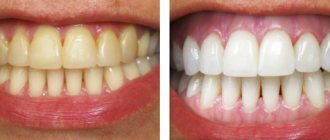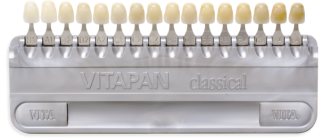Teeth whitening in dentistry
It seems to modern people that snow-white teeth have always been an integral attribute of an attractive appearance, but this is far from the case. During the Roman Empire, wearing gold dentures was considered a blessing—a symbol of power and prosperity (by the way, in Russia, gold crowns once played the same role). The aristocracy of the Middle Ages was proud of rotten teeth - a sign of high origin and wealth. In Ancient China, things were no better: women deliberately made their smile black in order to please the future groom. Of course, darkened teeth were not held in high esteem everywhere and not at all times, and there were people who were looking for more and more new means for whitening them.
Teeth whitening methods
All types of teeth whitening can be divided into professional and non-professional. The first ones are carried out by a doctor in a clinic or by the patient himself at home under the supervision of a doctor. These include methods such as photobleaching, laser, chemical bleaching, endobleaching and home whitening using caps. Each of the listed methods of teeth whitening has its own pros and cons, indications and contraindications.
The second group includes various whitening products that can be purchased freely and used independently without the participation of a specialist. We are talking, first of all, about whitening pastes. Non-professional whitening includes special whitening plates, pencils and systems with universal trays, but doctors still do not recommend using them yourself, since careless use of such products can lead to complications such as sharp pain during whitening and increased tooth sensitivity after it.
Effective teeth whitening
Before the patient agrees to whitening, the doctor must warn that the results may be disappointing. This is especially true for complex cases, such as teeth with fluorosis. In addition, the patient should be warned about the possible replacement of old restorations. Whitening of fillings, crowns, veneers or implants is not possible.
The most effective methods of teeth whitening are professional techniques. The leading place in terms of effectiveness is occupied by laser whitening, which to some extent can even cope with tetracycline teeth. Then comes photobleaching - the most famous and popular in-office technique today. Closing the top three is the chemical technique, which is used very rarely, but definitely deserves attention. Home professional whitening is also quite effective, but to get results you need to take a fairly long course.
As for non-professional whitening systems, the most effective of them are those that contain hydrogen peroxide or carbamide peroxide. All other products without the listed active whitening substances have only a good cleaning effect from plaque and polishing the tooth surface.
If we talk about the effectiveness of whitening in general, then, even when using the same product, different patients will have different results. The best and fastest effect is achieved by whitening teeth with natural yellowish tints; teeth with grayish shades are less bleached. And although everything depends on the specific case, to say that the effect of the procedure is completely unpredictable is also wrong. A dentist who has good practice can predict the outcome in simple clinical cases.
How to keep your teeth white longer
Depending on the technique used, the effect of professional whitening can last for more than one year. However, some patients return to the clinic after a few months for a repeat procedure. To ensure that your smile remains dazzling for a long time, doctors recommend adhering to the following rules:
- do not eat for 3 hours after teeth whitening, you can only drink clean water, then you must adhere to a special diet;
- Do not use a brush with hard bristles, as this will only increase sensitivity;
- purchase a paste without abrasive particles;
- rinse your mouth, use dental floss, and irrigator after each meal;
- Mouth rinses should not contain chlorhexidine (it stains teeth);
- follow a schedule of visits to the dentist for preventive examinations (at least once every six months);
- complete smoking cessation for 2-3 days, preferably for several weeks.
Special diet
To maintain the effect for a long time immediately after the procedure, you must adhere to a special diet. It is important to minimize the consumption of foods with bright colors. It is advisable to eat:
- porridge;
- dairy (but not fermented milk) products;
- fish and seafood;
- chicken, rabbit;
- egg white;
- white fruits and vegetables (such as bananas).
Along with eliminating food containing dyes from the diet, it is recommended to avoid coloring spices. This is turmeric, paprika. Dentists also do not advise eating smoked meats, citrus fruits, any berries, drinking coffee, black tea and alcoholic beverages.
Composition of whitening gels
For various methods of professional and non-professional teeth whitening, special whitening gels are used, the active substances of which are hydrogen peroxide or carbamide. Sometimes the preparations include amorphous calcium phosphate, fluoride or potassium nitrate to treat minor damage to the enamel, as well as to make teeth brighter and glossier after the procedure. In some cases, the whitening gel may contain special components that have a soothing effect on the teeth and gums.
Ineffective and dangerous techniques
Home teeth whitening with activated carbon, soda, hydrogen peroxide, and whitening pharmaceutical products is divided into two categories: dangerous and ineffective.
When using whitening toothpastes, powders, varnishes, and soda, practically no results are observed. But there are contraindications. These drugs are harmful for people with sensitive gums.
Activated carbon, hydrogen peroxide, various alkaline and acidic bleaching solutions are dangerous. They destroy enamel, lead to burns of the mucous membrane, and poisoning.
Before using advice you read on the Internet, you should contact your dentist. He will recommend relatively safe and effective methods for at-home teeth whitening.
Teeth whitening procedure
In the whitening procedure, it is very important to strictly follow its protocol.
- Before you start whitening your teeth, you need to conduct a diagnosis: find out the reason for the change in the color of the tooth enamel, take an x-ray, examine the gums and check the condition of the teeth. Based on the data obtained, the doctor selects the whitening system that is most suitable in this case.
- This is followed by mandatory professional teeth cleaning.
- Before and after the whitening procedure, remineralization therapy is performed.
- Rapid in-office teeth whitening is performed in the clinic directly by a dental hygienist. A gel with a whitening agent concentration of at least 30% is applied to the teeth, which is activated by light, laser, or acts on its own. The duration of the procedure depends on the specific technique, but, as a rule, only one visit is required. For home whitening in dentistry, individual trays are made, and a suitable whitening gel is selected. The patient carries out the procedure itself at home, following the doctor’s recommendations. The gel is applied to trays, which are placed on the teeth and worn once or twice a day or left overnight, depending on the teeth whitening technology. The course can last from two weeks to a month.
- At the end of the procedure, the result obtained is assessed using the VITA scale.
Important!
After teeth whitening, you should not smoke, drink red wine or coffee, or consume any foods with strong coloring pigments, such as red berries and beets.
The effect of white teeth can last from six months to several years. It is very difficult to say exactly how long teeth whitening will last, since it depends on many factors. To maintain long-term results, it is recommended to use maintenance whitening products for home use - pastes or rinses, as well as adhere to a transparent diet. In addition, good oral care and regular professional cleanings can also help maintain a snow-white smile for a long time. It is likely that sooner or later the procedure will have to be repeated, but according to many experts, the original color of the teeth will not return.
Advantages and disadvantages of the procedure
Positive sides:
- Quick results. In a single visit, you can noticeably lighten the enamel by several tones, the effect depends on its condition.
- No medical indications. The client of the dental clinic decides for himself whether he needs to whiten his teeth.
- Many methods with different effects and prices.
- No pain or other discomfort.
- Almost all methods are universal, which means they can be used for patients of different ages.
- There is no need to go through a recovery period.
- Getting rid of complexes and awkwardness when communicating with others.
The technique also has negative aspects:
- The most effective methods have a high cost.
- The effect does not last long. The smile will remain snow-white for 5-7 years, but no more.
- Increased sensitivity of enamel, its thinning. Pain may occur while eating if the food or water is too cold or too hot.
- Inability to change the color of filling material, implants, artificial crowns.
- The risk of losing the natural shade of teeth and excessive whiteness increases.
- The need to adhere to dietary nutrition to maintain results. It is not recommended to drink coffee, strong black tea, or eat foods with a high concentration of bright natural pigment.
Complications after teeth whitening
The most common problem that patients encounter after whitening is increased tooth sensitivity. The cause of painful sensations is the process as a result of which the teeth, under the influence of the whitening gel, lose moisture and are then re-saturated with liquid. Remineralizing therapy before the procedure and the use of special medications help neutralize pain after teeth whitening. Increased tooth sensitivity can also be relieved by taking painkillers.
Should I whiten my teeth before getting a crown?
No whitening is required before placing a crown. However, if you are planning prosthetics in the smile area and at the same time want to improve its aesthetic parameters, you can pre-whiten your teeth.
This issue should only be resolved together with your doctor. He will assess your condition and make recommendations on the best combination of treatments.
Professional teeth whitening before restoration and prosthetics is justified, because if the enamel has already darkened and you ever decide to whiten your teeth, the crown will retain its shade.











